warning MAZDA MODEL 3 HATCHBACK 2006 Owner's Manual (in English)
[x] Cancel search | Manufacturer: MAZDA, Model Year: 2006, Model line: MODEL 3 HATCHBACK, Model: MAZDA MODEL 3 HATCHBACK 2006Pages: 372, PDF Size: 5.55 MB
Page 271 of 372
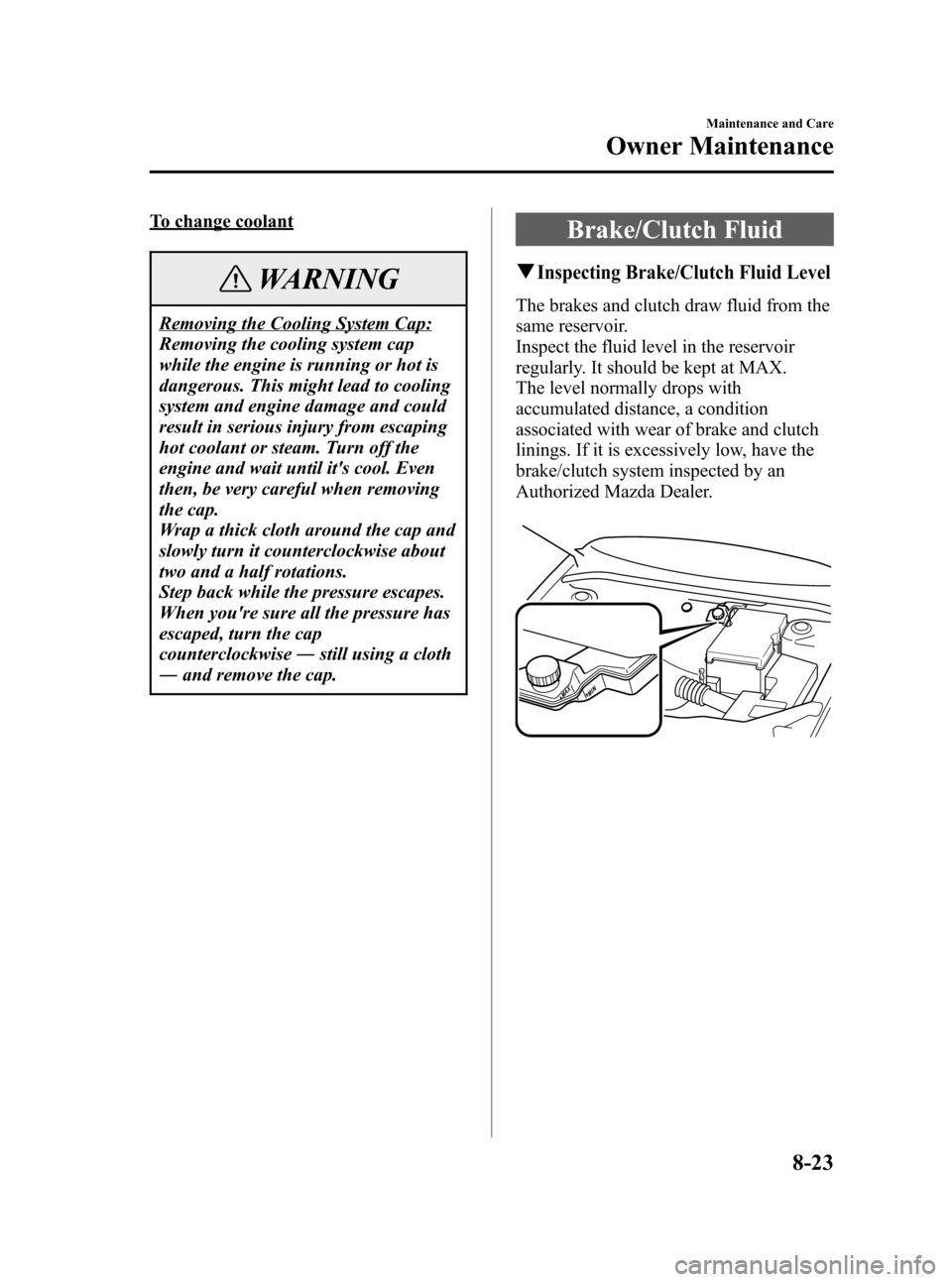
Black plate (271,1)
To change coolant
WARNING
Removing the Cooling System Cap:
Removing the cooling system cap
while the engine is running or hot is
dangerous. This might lead to cooling
system and engine damage and could
result in serious injury from escaping
hot coolant or steam. Turn off the
engine and wait until it's cool. Even
then, be very careful when removing
the cap.
Wrap a thick cloth around the cap and
slowly turn it counterclockwise about
two and a half rotations.
Step back while the pressure escapes.
When you're sure all the pressure has
escaped, turn the cap
counterclockwise―still using a cloth
―and remove the cap.
Brake/Clutch Fluid
qInspecting Brake/Clutch Fluid Level
The brakes and clutch draw fluid from the
same reservoir.
Inspect the fluid level in the reservoir
regularly. It should be kept at MAX.
The level normally drops with
accumulated distance, a condition
associated with wear of brake and clutch
linings. If it is excessively low, have the
brake/clutch system inspected by an
Authorized Mazda Dealer.
Maintenance and Care
Owner Maintenance
8-23
Mazda3_8U55-EA-05G_Edition2 Page271
Thursday, June 23 2005 2:56 PM
Form No.8U55-EA-05G
Page 272 of 372

Black plate (272,1)
qAdding Brake/Clutch Fluid
WARNING
Spilled Brake Fluid:
Spilled brake fluid is dangerous. If it
gets in your eyes, they could be
seriously injured. If this happens,
immediately flush your eyes with water
and get medical attention. Brake fluid
spilled on a hot engine could cause a
fire. Be careful not to spill brake fluid
on yourself or on the engine.
Low Brake/Clutch Fluid Levels:
Low brake/clutch fluid levels are
dangerous. Low levels could signal
brake lining wear or a brake system
leak. Your brakes could fail and cause
an accident. If you find a low fluid
level, have the brakes and clutch
inspected.
If the fluid level is low, add fluid until it
reaches MAX.
Before adding fluid, thoroughly clean the
area around the cap.
CAUTION
lBrake and clutch fluid will damage
painted surfaces. If brake or clutch
fluid does get on a painted surface,
wipe it off immediately.
lUsing nonspecified brake and clutch
fluids (page 10-4) will damage the
systems. Mixing different fluids will
also damage them.
If the brake/clutch system frequently
requires new fluid, consult an
Authorized Mazda Dealer.
Power Steering Fluid
qInspecting Power Steering Fluid
Level
CAUTION
To avoid damage to the power steering
pump, don't operate the vehicle for long
periods when the power steering fluid
level is low.
NOTE
Use specified power steering fluid
(page 10-4).
Inspect the fluid level in the reservoir at
each engine oil change with the engine off
and cold. Add fluid if necessary; it does
not require periodic changing.
The level must be kept between MIN and
MAX.
Visually examine the lines and hoses for
leaks and damage.
If new fluid is required frequently, consult
an Authorized Mazda Dealer.
8-24
Maintenance and Care
Owner Maintenance
Mazda3_8U55-EA-05G_Edition2 Page272
Thursday, June 23 2005 2:56 PM
Form No.8U55-EA-05G
Page 274 of 372

Black plate (274,1)
9. Shift the shift lever to the park position
(P), check the ATF level while the
engine is idling, and make sure that the
ATF level is within the proper level. If
the ATF level is not within the proper
level, add ATF.
The proper fluid level is marked on the
dipstick as follows.
Full
OK
Low
2.0-liter engine
The volume of fluid changes with the
temperature. Fluid must be checked at idle
without driving at normal operating
temperature.
CAUTION
lLow fluid level causes transaxle
slippage. Overfilling can cause
foaming, loss of fluid, and transaxle
malfunction.
lUse specified fluid (page 10-4). A
nonspecified fluid could result in
transaxle malfunction and failure.
1. Park on a level surface and set the
parking brake firmly.
2. Start the engine and depress the brake
pedal.3. Move the shift lever through all ranges
and set it at P.
WARNING
Sudden Vehicle Movement:
Shifting the shift lever without first
depressing the brake pedal is
dangerous. The vehicle could move
suddenly and cause an accident.
Make sure the brake pedal is applied
before shifting the shift lever.
4. With the engine still idling, pull out the
dipstick, wipe it clean, and put it back.
5. Pull it out again.
The proper fluid level is marked on the
dipstick as follows.
Full
A
LowFull
B
Low
Fluid hot scale A
When the vehicle has been driven and the
fluid is at normal operating temperature,
about 65°C (150°F), the level must be
between Full and Low.
8-26
Maintenance and Care
Owner Maintenance
Mazda3_8U55-EA-05G_Edition2 Page274
Thursday, June 23 2005 2:56 PM
Form No.8U55-EA-05G
Page 275 of 372
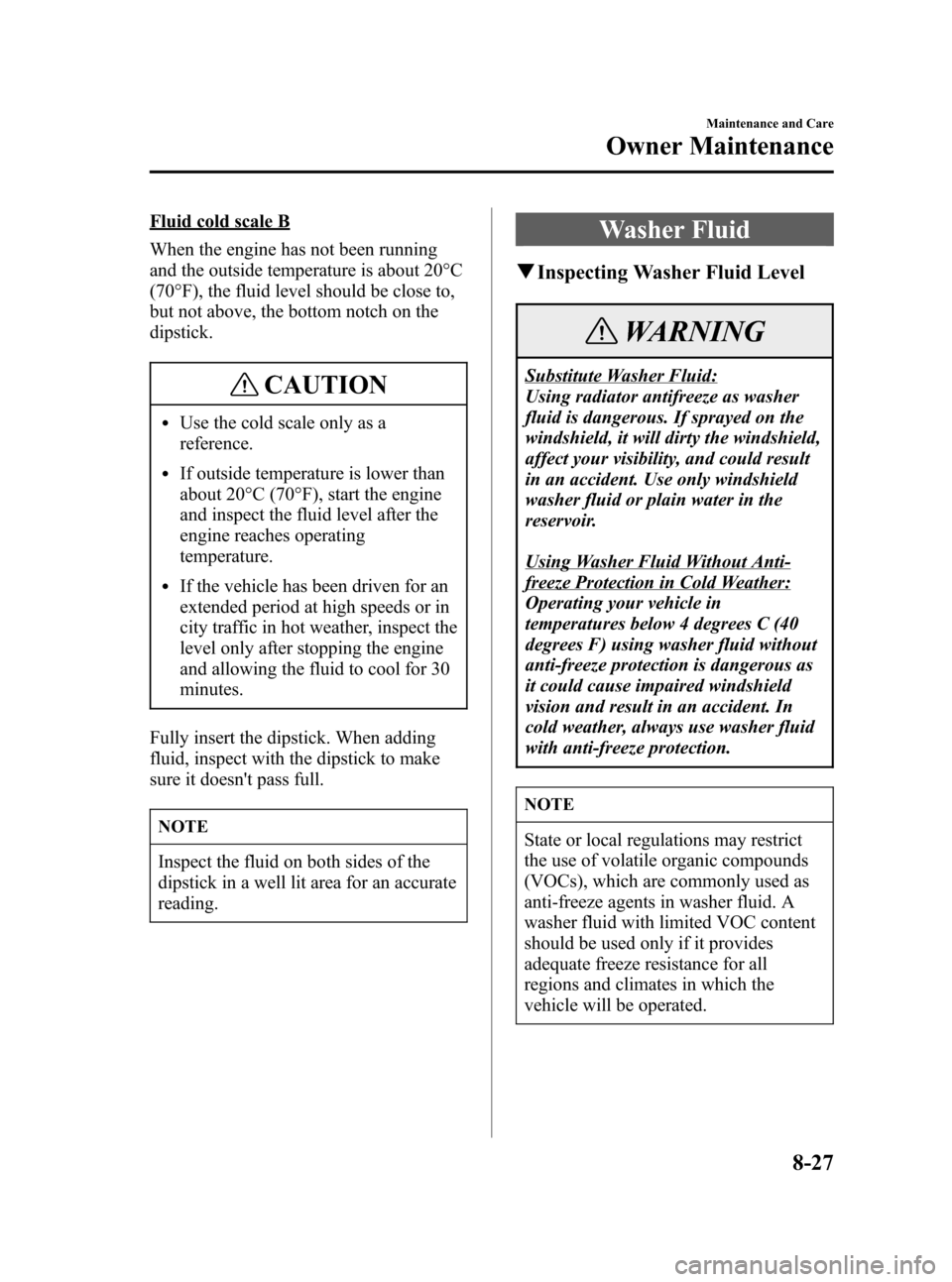
Black plate (275,1)
Fluid cold scale B
When the engine has not been running
and the outside temperature is about 20°C
(70°F), the fluid level should be close to,
but not above, the bottom notch on the
dipstick.
CAUTION
lUse the cold scale only as a
reference.
lIf outside temperature is lower than
about 20°C (70°F), start the engine
and inspect the fluid level after the
engine reaches operating
temperature.
lIf the vehicle has been driven for an
extended period at high speeds or in
city traffic in hot weather, inspect the
level only after stopping the engine
and allowing the fluid to cool for 30
minutes.
Fully insert the dipstick. When adding
fluid, inspect with the dipstick to make
sure it doesn't pass full.
NOTE
Inspect the fluid on both sides of the
dipstick in a well lit area for an accurate
reading.
Washer Fluid
qInspecting Washer Fluid Level
WARNING
Substitute Washer Fluid:
Using radiator antifreeze as washer
fluid is dangerous. If sprayed on the
windshield, it will dirty the windshield,
affect your visibility, and could result
in an accident. Use only windshield
washer fluid or plain water in the
reservoir.
Using Washer Fluid Without Anti-
freeze Protection in Cold Weather:
Operating your vehicle in
temperatures below 4 degrees C (40
degrees F) using washer fluid without
anti-freeze protection is dangerous as
it could cause impaired windshield
vision and result in an accident. In
cold weather, always use washer fluid
with anti-freeze protection.
NOTE
State or local regulations may restrict
the use of volatile organic compounds
(VOCs), which are commonly used as
anti-freeze agents in washer fluid. A
washer fluid with limited VOC content
should be used only if it provides
adequate freeze resistance for all
regions and climates in which the
vehicle will be operated.
Maintenance and Care
Owner Maintenance
8-27
Mazda3_8U55-EA-05G_Edition2 Page275
Thursday, June 23 2005 2:56 PM
Form No.8U55-EA-05G
Page 282 of 372

Black plate (282,1)
Battery
WARNING
Battery-Related Lead Materials:
Battery posts, terminals and related accessories contain lead and lead compounds,
chemicals known to the State of California to cause cancer and reproductive harm.
Wash hands after handling.
Follow These Precautions Carefully:
To ensure safe and correct handling of the battery, read the following precautions
carefully before using the battery or inspecting it.
Eye Protection:
Working without eye protection is dangerous. Battery fluid contains SULFURIC
ACID which could cause blindness if splashed into your eyes. Also, hydrogen gas
produced during normal battery operation, could ignite and cause the battery to
explode. Always wear eye protection when working near the battery.
Spilled Battery Fluid:
Spilled battery fluid is dangerous.
Battery fluid contains SULFURIC ACID which could cause serious injuries if it gets
in eyes, skin or clothing. If this happens, immediately flush your eyes with water for
15 minutes or wash your skin thoroughly and get medical attention. Wear eye
protection and protective gloves to prevent contact with battery fluid.
Children and Batteries:
Allowing children to play near batteries is dangerous. Battery fluid could cause
serious injuries if it gets in the eyes or on the skin. Always keep batteries out of the
reach of children.
8-34
Maintenance and Care
Owner Maintenance
Mazda3_8U55-EA-05G_Edition2 Page282
Thursday, June 23 2005 2:56 PM
Form No.8U55-EA-05G
Page 283 of 372

Black plate (283,1)
WARNING
Keep Flames Away:
Flames and sparks near open battery cells are dangerous. Hydrogen gas, produced
during normal battery operation, could ignite and cause the battery to explode. An
exploding battery can cause serious burns and injuries. Keep all flames including
cigarettes and sparks away from open battery cells. When working near a battery, do
not allow metal tools to contact the positive (
) or negative () terminal of the
battery. Do not allow the positive (
) terminal to contact the vehicle body.
Battery-Related Explosion:
Flames and sparks near open battery cells are dangerous. Hydrogen gas, produced
during normal battery operation, could ignite and cause the battery to explode. An
exploding battery can cause serious burns and injuries. Keep all flames, including
cigarettes, and sparks away from open battery cells.
Maintenance and Care
Owner Maintenance
8-35
Mazda3_8U55-EA-05G_Edition2 Page283
Thursday, June 23 2005 2:56 PM
Form No.8U55-EA-05G
Page 285 of 372
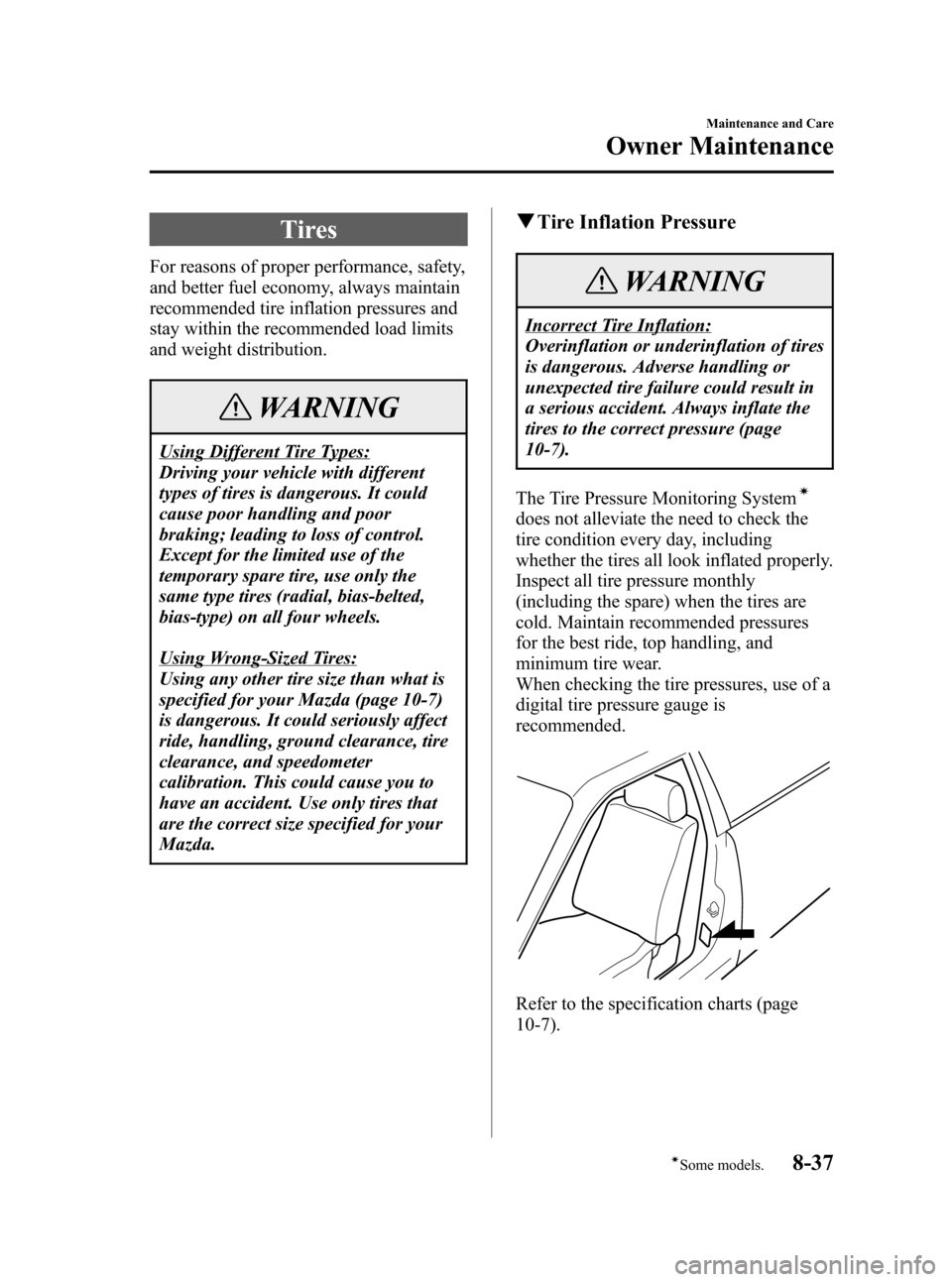
Black plate (285,1)
Tires
For reasons of proper performance, safety,
and better fuel economy, always maintain
recommended tire inflation pressures and
stay within the recommended load limits
and weight distribution.
WARNING
Using Different Tire Types:
Driving your vehicle with different
types of tires is dangerous. It could
cause poor handling and poor
braking; leading to loss of control.
Except for the limited use of the
temporary spare tire, use only the
same type tires (radial, bias-belted,
bias-type) on all four wheels.
Using Wrong-Sized Tires:
Using any other tire size than what is
specified for your Mazda (page 10-7)
is dangerous. It could seriously affect
ride, handling, ground clearance, tire
clearance, and speedometer
calibration. This could cause you to
have an accident. Use only tires that
are the correct size specified for your
Mazda.
qTire Inflation Pressure
WARNING
Incorrect Tire Inflation:
Overinflation or underinflation of tires
is dangerous. Adverse handling or
unexpected tire failure could result in
a serious accident. Always inflate the
tires to the correct pressure (page
10-7).
The Tire Pressure Monitoring System
í
does not alleviate the need to check the
tire condition every day, including
whether the tires all look inflated properly.
Inspect all tire pressure monthly
(including the spare) when the tires are
cold. Maintain recommended pressures
for the best ride, top handling, and
minimum tire wear.
When checking the tire pressures, use of a
digital tire pressure gauge is
recommended.
Refer to the specification charts (page
10-7).
Maintenance and Care
Owner Maintenance
8-37íSome models. Mazda3_8U55-EA-05G_Edition2 Page285
Thursday, June 23 2005 2:56 PM
Form No.8U55-EA-05G
Page 287 of 372
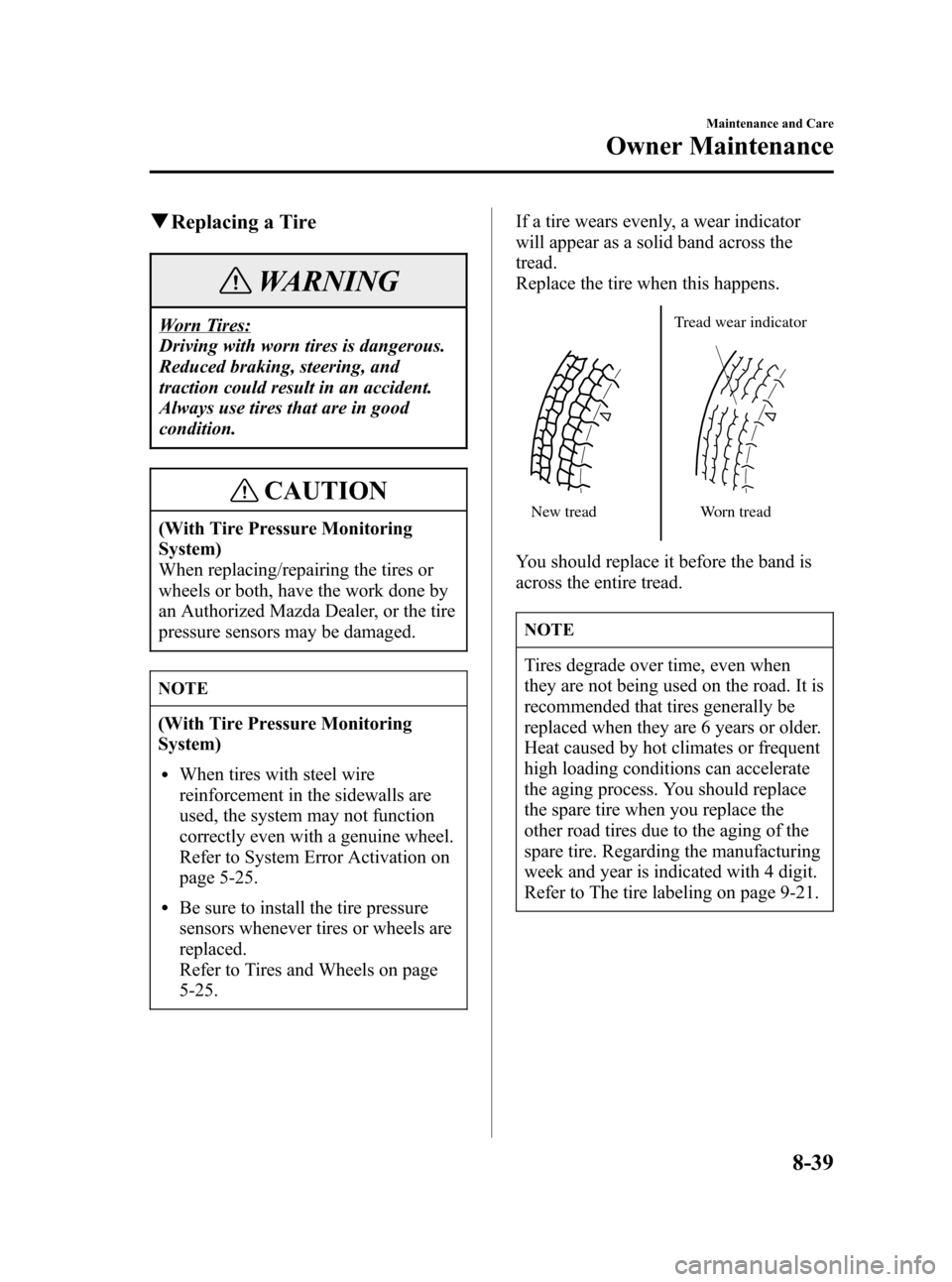
Black plate (287,1)
qReplacing a Tire
WARNING
Worn Tires:
Driving with worn tires is dangerous.
Reduced braking, steering, and
traction could result in an accident.
Always use tires that are in good
condition.
CAUTION
(With Tire Pressure Monitoring
System)
When replacing/repairing the tires or
wheels or both, have the work done by
an Authorized Mazda Dealer, or the tire
pressure sensors may be damaged.
NOTE
(With Tire Pressure Monitoring
System)
lWhen tires with steel wire
reinforcement in the sidewalls are
used, the system may not function
correctly even with a genuine wheel.
Refer to System Error Activation on
page 5-25.
lBe sure to install the tire pressure
sensors whenever tires or wheels are
replaced.
Refer to Tires and Wheels on page
5-25.If a tire wears evenly, a wear indicator
will appear as a solid band across the
tread.
Replace the tire when this happens.
New treadTread wear indicator
Worn tread
You should replace it before the band is
across the entire tread.
NOTE
Tires degrade over time, even when
they are not being used on the road. It is
recommended that tires generally be
replaced when they are 6 years or older.
Heat caused by hot climates or frequent
high loading conditions can accelerate
the aging process. You should replace
the spare tire when you replace the
other road tires due to the aging of the
spare tire. Regarding the manufacturing
week and year is indicated with 4 digit.
Refer to The tire labeling on page 9-21.
Maintenance and Care
Owner Maintenance
8-39
Mazda3_8U55-EA-05G_Edition2 Page287
Thursday, June 23 2005 2:56 PM
Form No.8U55-EA-05G
Page 288 of 372
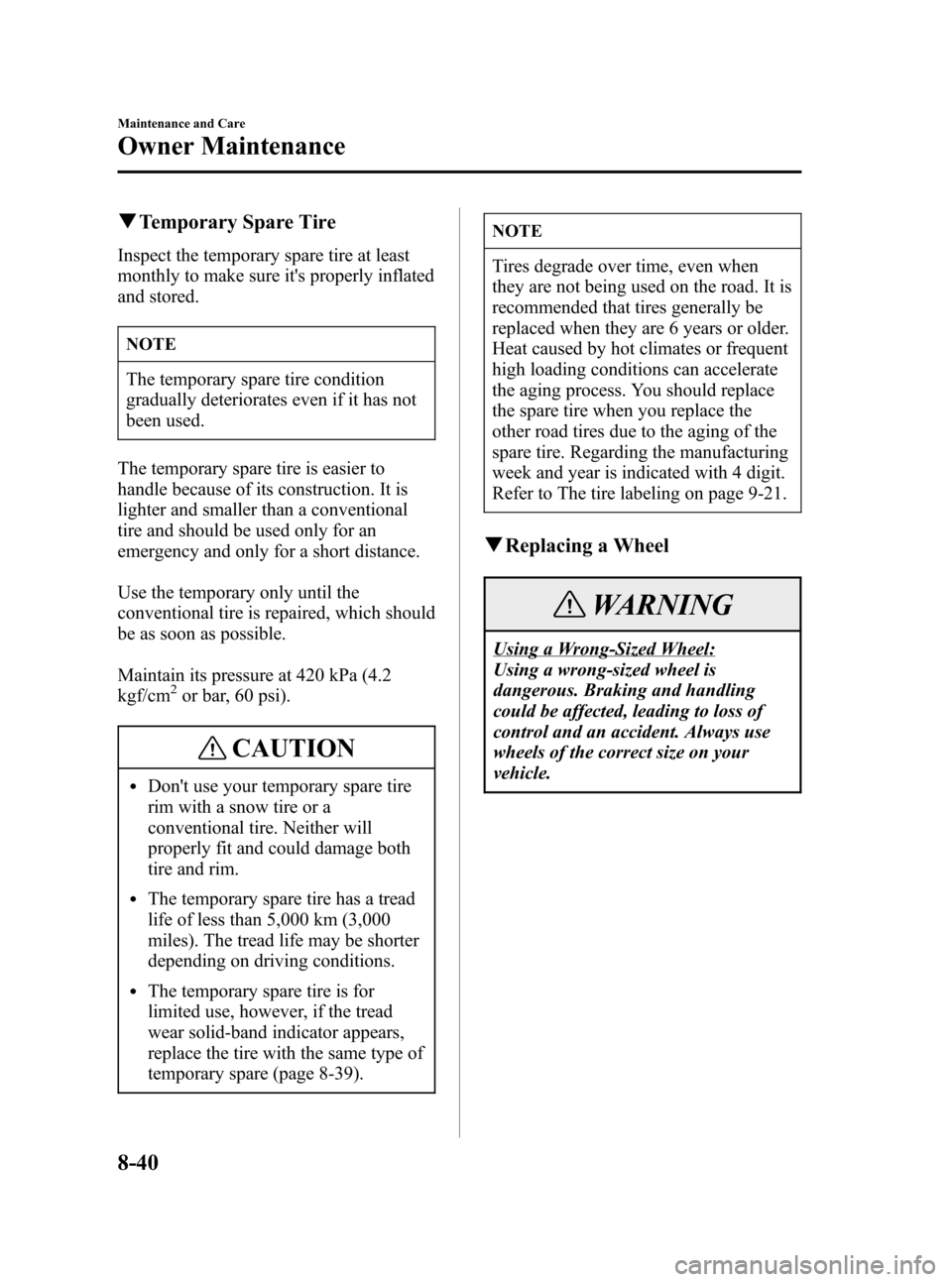
Black plate (288,1)
qTemporary Spare Tire
Inspect the temporary spare tire at least
monthly to make sure it's properly inflated
and stored.
NOTE
The temporary spare tire condition
gradually deteriorates even if it has not
been used.
The temporary spare tire is easier to
handle because of its construction. It is
lighter and smaller than a conventional
tire and should be used only for an
emergency and only for a short distance.
Use the temporary only until the
conventional tire is repaired, which should
be as soon as possible.
Maintain its pressure at 420 kPa (4.2
kgf/cm
2or bar, 60 psi).
CAUTION
lDon't use your temporary spare tire
rim with a snow tire or a
conventional tire. Neither will
properly fit and could damage both
tire and rim.
lThe temporary spare tire has a tread
life of less than 5,000 km (3,000
miles). The tread life may be shorter
depending on driving conditions.
lThe temporary spare tire is for
limited use, however, if the tread
wear solid-band indicator appears,
replace the tire with the same type of
temporary spare (page 8-39).
NOTE
Tires degrade over time, even when
they are not being used on the road. It is
recommended that tires generally be
replaced when they are 6 years or older.
Heat caused by hot climates or frequent
high loading conditions can accelerate
the aging process. You should replace
the spare tire when you replace the
other road tires due to the aging of the
spare tire. Regarding the manufacturing
week and year is indicated with 4 digit.
Refer to The tire labeling on page 9-21.
qReplacing a Wheel
WARNING
Using a Wrong-Sized Wheel:
Using a wrong-sized wheel is
dangerous. Braking and handling
could be affected, leading to loss of
control and an accident. Always use
wheels of the correct size on your
vehicle.
8-40
Maintenance and Care
Owner Maintenance
Mazda3_8U55-EA-05G_Edition2 Page288
Thursday, June 23 2005 2:56 PM
Form No.8U55-EA-05G
Page 291 of 372
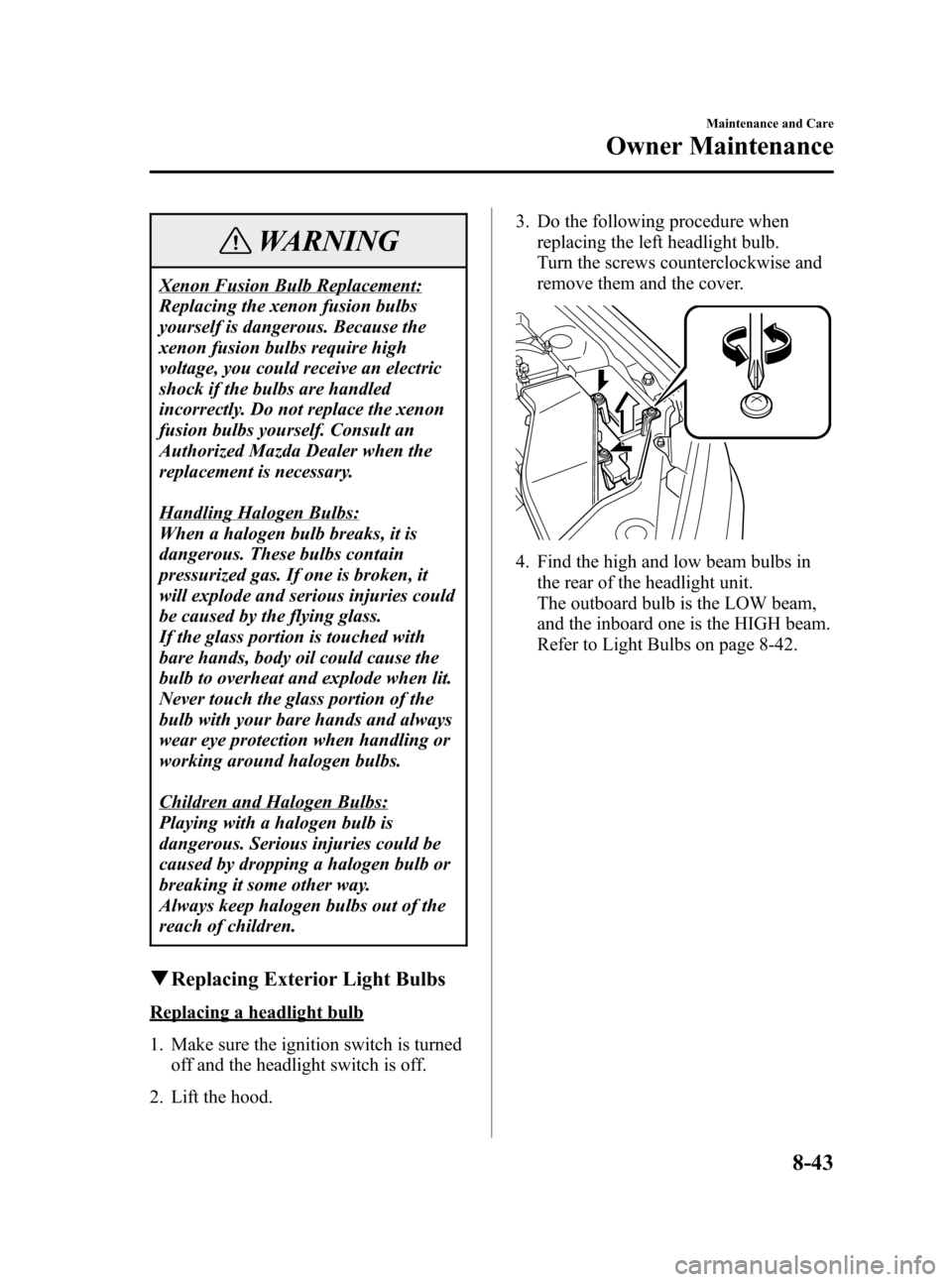
Black plate (291,1)
WARNING
Xenon Fusion Bulb Replacement:
Replacing the xenon fusion bulbs
yourself is dangerous. Because the
xenon fusion bulbs require high
voltage, you could receive an electric
shock if the bulbs are handled
incorrectly. Do not replace the xenon
fusion bulbs yourself. Consult an
Authorized Mazda Dealer when the
replacement is necessary.
Handling Halogen Bulbs:
When a halogen bulb breaks, it is
dangerous. These bulbs contain
pressurized gas. If one is broken, it
will explode and serious injuries could
be caused by the flying glass.
If the glass portion is touched with
bare hands, body oil could cause the
bulb to overheat and explode when lit.
Never touch the glass portion of the
bulb with your bare hands and always
wear eye protection when handling or
working around halogen bulbs.
Children and Halogen Bulbs:
Playing with a halogen bulb is
dangerous. Serious injuries could be
caused by dropping a halogen bulb or
breaking it some other way.
Always keep halogen bulbs out of the
reach of children.
qReplacing Exterior Light Bulbs
Replacing a headlight bulb
1. Make sure the ignition switch is turned
off and the headlight switch is off.
2. Lift the hood.3. Do the following procedure when
replacing the left headlight bulb.
Turn the screws counterclockwise and
remove them and the cover.
4. Find the high and low beam bulbs in
the rear of the headlight unit.
The outboard bulb is the LOW beam,
and the inboard one is the HIGH beam.
Refer to Light Bulbs on page 8-42.
Maintenance and Care
Owner Maintenance
8-43
Mazda3_8U55-EA-05G_Edition2 Page291
Thursday, June 23 2005 2:56 PM
Form No.8U55-EA-05G